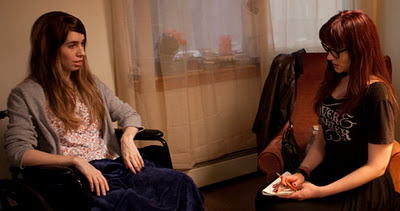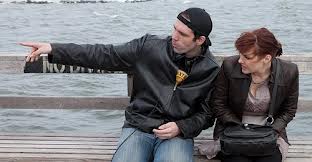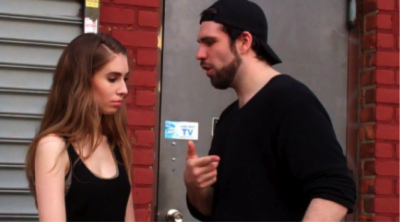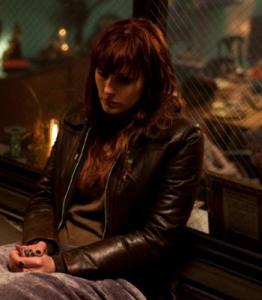By: debbie lynn elias
It’s always a joy to be introduced to a “new” filmmaker, a “first time helmer”, and be able to join them in their cinematic journey, watching them grow, progress, develop voice and tone unique to them, and all the while develop personal relationships and friendships that grow and stand the test of time, and critical review of their work. One of those filmmakers who has become special for me is David Spaltro.
A New Jersey native with a heart rooted in New York City, Spaltro has a solid background when it comes to directorial training. With a BFA in Directing from the School of Visual Arts under his belt, Spaltro gained precious life experience traveling, as well as practical experience, honing his skills as an editor and in post-production. By 2007, he was ready to show the world some of what he had learned about life and filmmaking, making his directorial debut in 2009 with …Around. Receiving critical acclaim, …Around even found its way onto PBS. And that took Spaltro to the next rung on the ladder – THINGS I DON’T UNDERSTAND.

As we saw with …Around, Spaltro has a gift for exposing the raw beauty and truth of life. He does just that and more with THINGS I DON’T UNDERSTAND. Retaining the intimate sensibility often associated with independent films, but complimented with high production values and performances, THINGS I DON’T UNDERSTAND has a “personal touch” that will resonate with something in each of us. Eloquently blending universal themes of life and death, family, home, health and heart, set against a backdrop exploration of faith versus logic stemming from his protagonist’s intellectual obsession and own broken past, what could have proven to be a mish-mash of philosophical double talk is instead an enlightening and engaging movie-going experience.
Along for the ride since some of its earliest days, as THINGS I DON’T UNDERSTAND wends its way to Los Angeles as part of the 5th Annual Lady Filmmakers Film Festival for a screening at the Charles Aidikoff Screening Room in Beverly Hills on Saturday, September 28, 2013 at 3:30 p.m. (at which one of the film’s stars, Grace Folsom, will be present for Q&A), I finally snared David for this exclusive interview on THINGS I DON’T UNDERSTAND, the future and Spaltro’s own winning independent spirit.

From where did the story of THINGS I DON’T UNDERSTAND come? Your inspiration?
THINGS and its origin is kind of funny, as it originally started out as a short film I had been writing as my potential film school final thesis film. I had always wanted to set something in the world of a hospice, as I had some experience working/volunteering in one. I’d written out a lot of what became the two scenes between Violet and Sara in the hospice, a grad student interviewing a terminally ill girl, talking about life, death, the world, but it really didn’t have a story. It was more of a one act play, and excuse to have people chat about some themes/ideas I was interested in. I had put the pages away, and then, after being very burned out when completing my first film …Around, going through some things, I found the old scenes and started fleshing out a full story, less to even make a film, but more of a cathartic writing exercise. It all just kind of clicked with the added time and experience, and also a desire to work with Molly Ryman again, and give her a much darker role.
The character of Violet is flawed, emotionally broken, yet pragmatic and filled with hope, making her a very inspirational character and is one of those characters that could have been written as either a man or a woman. What were your concerns when creating Violet in terms of her traits, emotions, etc.?
I didn’t really worry about the character when writing her, as, with anything, it’s just letting your subconscious, story, and voices of the character take over. I felt like I knew her very well, as Violet is very much a representation of where I was at in my mid-twenties, angrier and questioning things, very burned out. I think the concern was always about making her translate from the page and into the reality of a film, as an audience connecting to someone who does a lot of things that could be very frustrating or unlikable. You need to relate, care, connect with and want to see this person redeem themselves. You need to root for them, and part of casting Molly was that I felt she had that inner spark and likability, a fragility and humanity, that you could root for and connect with, even when doing and saying awful things.
The performances in THINGS are truly outstanding. What led you to cast the now very decorated actress Molly Ryman as Violet?
I had enjoyed working with Molly on my first film, and while on set she had told me she really wanted to try to break out of the “girl next door” role she was typecast in, and in many ways, even bringing some edge, [that she] played in my first film. I got to know her quite well in the year we made the film […Around] and finished it, and also on set could see her just doing some very interesting things, being very darkly funny. I also think there’s this natural warmth and energy to Molly, an urgent immediacy that is at both times disarming and intensely likable, yet still very unpredictable. I felt like, more than any other talented actor I knew, she was ready to carry an ensemble film and take on this role. She’d be the light in the Violet candle that wouldn’t make an audience run in disgust from her, and I’ve heard many audience members at film festivals say, “You know we really started to dislike this character, but… something just kept us hooked…”. That’s all Molly.

Equally important to THINGS is the character of Sara Lowe. Is she based on someone you know or knew? Given the character’s illness, how did you approach her creation with the sensitivity that we see on screen and how did that play into your casting of Grace Folsom?
Grace Folsom is just an incredibly talented performer, even at the young age she was cast. She’s just so instinctual and intuitive, works really hard and prepares thoroughly. She also has this aura or energy about her, the way she just supports a scene or the lines, goes with the flow and draws you in. Her natural demeanor is delightful, energetic, almost kind of like a nervous or anxious puppy. Full of happiness and positivity. She was a delight on set, and then when we got into the work of building Sara, the hospice, she just drew on all these real lived in and pain places, and really brought together this multi-leveled performance that just crushes every time we screen the film. This young girl, losing her life and going through being brave and still being a vulnerable child, she just nails it. I think she has a fascinating career ahead of her, and I’m very excited to do something else with her and see her other work.
As the writer/director, and also the film’s editor, what was your production process, i.e., in terms of writing, did you visualize each shot as you wrote the script? As a director, did you storyboard or shot list?
For myself, in the work I’ve done, I think being a writer/director/editor allows a lot of chance to really workshop the film through the different stages. However, the particulars change in different drafts, edits, or shots on set – you’re still trying to have a clear vision of what the story is about, what we’re trying to do in this scene, etc; so while everything else goes through shifts and changes based on the other artists you bring aboard for collaboration as actors and crew, you’re still having this one idea of what the film is, what we’re trying to say and filter it out through there. I think being able to know the characters and rewrite a scene on set or during a rehearsal to best serve that, or sometimes, as an editor, knowing how much coverage we need or when to do a half take, knowing what I’ve got and am going to do later, really comes in handy, particularly when running low on time.

As you know, I am thrilled with the Gus Sacks’ cinematography which adds so much to the visual and emotional palettes of THINGS. What considerations did you and Gus have in designing the lighting and lensing to create this wonderful tonal bandwidth that compliments the emotions and emotional conflict of the characters?
The best gift Gus gave me was his ability and knowledge, and the great team he brought. That allowed me to trust we could push ourselves visually, even with limited time and budget, and really create a look and feel with the world. We talked at length in pre-production about Violet’s different worlds of the loft, the hospice, and the bar –h ow the overall look of this NYC valentine was and how they each had their own character. His collaboration for the third time on this film, with the insanely talented gaffer Andrew Hubbard and production designer Emmeline Wilks-Dupose really helped added an extra layer. I’m also a huge fan of his fearlessness to shoot a “dark” film and really play with low-lights, shadows. I learned a from working with Gus, and I’d recommend him to anyone else.
Talk to me about the music. So many director overlook the music and scoring as a whole, opting instead for “fillers” or recognizable tunes or “memorable notes” that stick with the audience as opposed to musical theme. The music of THINGS is definitely thematic in its construct and integral to the thematic elements of the film as a whole. How did you come to work with Vita Tanga and what were some of the elements and considerations that you wanted the music to reflect?
Music is really important to me both in my life and artistically when creating something. I create playlists or listen to particular albums when working on something, and then, after we have shot something and I’m working on the first assembly edit, I’ll go back to those same songs and artists and use the music to help find the pace/tone in the edit. I’ve had the privilege to work with Carlos “Storm” Martinez and our composer Vita Tanga twice, on …Around and THINGS. With this project I was able to go to them in advance to talk about the story and our needs. We had a band within a band, Remy’s punk rock duo “It’s Only Hurts When I Oui” which they wrote original songs for, and helped assemble a band of musicians to play live at the now closed Brooklyn music venue Southpaw. For score, while …Around had a lot more acoustic guitar or straight up instruments, I wanted THINGS to have a strange organic feel. I had talked to Vita about the idea of using people’s voices as instruments, like an opera singer whose arias help open and close the film, as well as synthesizers like the early works of John Carpenter. I kind of wanted the music to be brooding, moody, yet also hopeful and full of humanity, a kind of a duality and constant struggle, like the movie itself. Giving him that information, the genius that he is, Vita just knocked it out of the park, and really got a chance to experiment and play. I think their work, the first time the fully produced score was laid in with the picture, just elevated everything so much. It was a movie. It was alive.

As you know, I am thrilled with the Gus Sacks’ cinematography which adds so much to the visual and emotional palettes of THINGS. What considerations did you and Gus have in designing the lighting and lensing to create this wonderful tonal bandwidth that compliments the emotions and emotional conflict of the characters?
The best gift Gus gave me was his ability and knowledge, and the great team he brought. That allowed me to trust we could push ourselves visually, even with limited time and budget, and really create a look and feel with the world. We talked at length in pre-production about Violet’s different worlds of the loft, the hospice, and the bar –h ow the overall look of this NYC valentine was and how they each had their own character. His collaboration for the third time on this film, with the insanely talented gaffer Andrew Hubbard and production designer Emmeline Wilks-Dupose really helped added an extra layer. I’m also a huge fan of his fearlessness to shoot a “dark” film and really play with low-lights, shadows. I learned a from working with Gus, and I’d recommend him to anyone else.
Talk to me about the music. So many director overlook the music and scoring as a whole, opting instead for “fillers” or recognizable tunes or “memorable notes” that stick with the audience as opposed to musical theme. The music of THINGS is definitely thematic in its construct and integral to the thematic elements of the film as a whole. How did you come to work with Vita Tanga and what were some of the elements and considerations that you wanted the music to reflect?
Music is really important to me both in my life and artistically when creating something. I create playlists or listen to particular albums when working on something, and then, after we have shot something and I’m working on the first assembly edit, I’ll go back to those same songs and artists and use the music to help find the pace/tone in the edit. I’ve had the privilege to work with Carlos “Storm” Martinez and our composer Vita Tanga twice, on …Around and THINGS. With this project I was able to go to them in advance to talk about the story and our needs. We had a band within a band, Remy’s punk rock duo “It’s Only Hurts When I Oui” which they wrote original songs for, and helped assemble a band of musicians to play live at the now closed Brooklyn music venue Southpaw. For score, while …Around had a lot more acoustic guitar or straight up instruments, I wanted THINGS to have a strange organic feel. I had talked to Vita about the idea of using people’s voices as instruments, like an opera singer whose arias help open and close the film, as well as synthesizers like the early works of John Carpenter. I kind of wanted the music to be brooding, moody, yet also hopeful and full of humanity, a kind of a duality and constant struggle, like the movie itself. Giving him that information, the genius that he is, Vita just knocked it out of the park, and really got a chance to experiment and play. I think their work, the first time the fully produced score was laid in with the picture, just elevated everything so much. It was a movie. It was alive.

What did you personally take away from the experience of making THINGS I DON’T UNDERSTAND?
I completely understand my job as a filmmaker and director now, more than I ever did on …Around or even starting THINGS. My job is to have that clear vision, be willing to push and fight for it, and be able to communicate it to all my people while they add and bring their abilities to achieving it. I’ve learned that if you believe in something, if you love it, and you work hard it finds its way into the project and helps it connect with people. They can see something that has the blood, sweat, tears and soul of so many great people trying to do something different and special. It becomes its own story. I learned that I can not sleep for ten days and that probably isn’t a good thing to do. I’ve learned that sometimes you have to just take a leap of faith and be willing to go the whole way, but most importantly be prepared and ready to fail. It could happen, and it shouldn’t be plan A… but allowing yourself the right to try and fail, to not back down and not even try, that’s huge. That’s where miracles grow.
What do you have up your sleeve next for us?
Wandering/Cut Films is currently in pre-production on our third and final NYC valentine, Wake Up In New York, which we’re in the financing and casting stage of to get off the ground and shoot this March/April. I’m going to be closing out the trilogy I started with …Around and THINGS with this film, a story of a writer and his ten year romance, told in flashback, with a bit of a Bohemian painter, that he’s reflecting on while he struggles to ghost rewrite a big budget science fiction epic in Hollywood, and finds his experiences bleeding into his work and current life. It’s a genre mash-up and maybe the most honest thing I’ve ever written, really utilizing everything I’ve learned about filmmaking and storytelling over the last seven years and putting it in this film. I’m going to be bringing in some new faces, but also some ones I’ve worked with before like Grace Folsom, Nabil Vinas. I’m going to be working with a very talented and lovely actress, Lynn Justinger, who had a small role in THINGS, and whose set presence was so great I just kept adding things and bringing her back more during the shoot. She’s just a real treasure and undiscovered gem. She’s got such great potential and work ethic, never phones it in, and I’m looking forward to working with her on this project.
I also am co-writing a screenplay adaptation of the novel “A Short Stay In Hell” with the author Stephen L. Peck. It’s this brilliant piece about a Mormon navigating a hell that is an almost infinite library of every book that can ever be written, where he has to find the story of his life completely proofread in order to leave. It’s about life, the meaning of infinity, love and relationships, and it’s just haunting and so full of ideas. I’ve never read anything like it, and everyone I’ve introduced to the book is excited and hooked, so I cannot wait for the world to see what we come up with this story. We’re also in the process of developing a TV pilot about a female goalie in circa 1993 Buffalo, NY called Hockeytown. There’s just so many ideas I’m playing with right now, and, after making these two films and closing out the trilogy, I feel free to explore my creative interests in many different areas. It’s been so much fun.
Given your passion and dedication for the art, we will obviously be seeing you around for a long time to come. So, I have to ask – What’s the greatest gift that filmmaking gives to you?
A family. I ended up with film as my medium, as hard as it is, because I just love collaboration. As a writer it’s you and your paper, or, at most, you and your editor, but with film you’re building this strange group of different artists all working long hours together, months at a time. It’s a family you trust, depend on and fight for. The films become these strange human scrapbooks, so when you’re watching them, sometimes way too many times at festivals, you’re not really watching the film – You’re flipping through an album and seeing the people you love.
# # #
9/14/13











